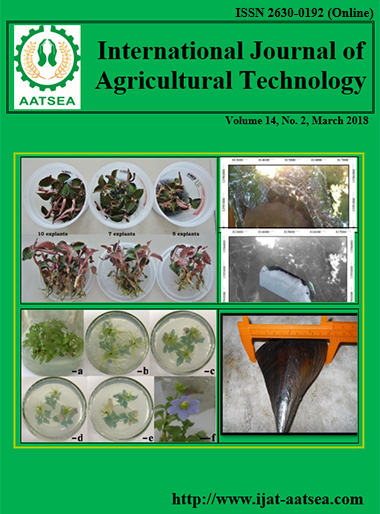Appropriate Proportion of Water Meal (Wolffia arrhiza (L.)) and Commercial Diet in Combined Feeding for Tilapia Fingerlings Rearing
Main Article Content
Abstract
Studying the growth performance of tilapia fingerlings fed with different proportions of dried water meal and commercial diet was carried out. The experiment consisted of 4 treatments and 3 replications that produced in 0.15 m3 circle cement pond (50 fingerlings per unit). Fingerlings were fed commercial diet (CD) combined with dried water meal (DWM) at 100:0 (control treatment), 70:30, 50:50 and 30:70 for 75 days and the average initial weight of fish were 0.82±0.02 g, 0.85±0.05 g, 0.76±0.11 g and 0.74±0.04 g respectively which no significant difference (p>0.05). The results indicated that fish gradually grew throughout the experiment. The average weight gain, average daily growth and average specific growth rate of fish fed with 100:0 of CD and DWM showed significantly higher (p<0.05) than other treatments (10.54±1.15 g 0.14±0.01 g day-1 and 3.54±0.14 % day-1 respectively). In the parts of feed conversion ratio, fish were fed 100:0 of CD and DWM showed significantly lower (p<0.05) than other treatments (1.61±0.18) but no significant difference when compared with 70:30 of CD and DWM feeding (2.21±0.58). DWM might not be suitable for direct feeding however its adventage could make fat accumulation in fish body lower than fish fed with 100% of CD and revealed high protein level in their body. The combined feeding between CD and DWM at 70:30 could reduce feed cost about 12.60% and showed no contrast on feed conversion ratio when compared with 100% CD feeding that is the best choice for DWM utilization.
Article Details

This work is licensed under a Creative Commons Attribution-NonCommercial-NoDerivatives 4.0 International License.
References
Anderson, J. S. and Lall, S. P. (1994). Nutritive value of fish meal for salmonids. In: MacKinlay, D. D. (Ed.), High performance fish. Proceedings of the International fish physiology symposium, University of British Columbia, Vancouver. pp. 389-393.
Ariyaratne, M. H. S. (2010). Poteintial of duckweed (Wolffia arrhiza) - an invasive aquatic plant as fish feed in tilapia (Oreochromis niloticus) fry rearing. Pakistan Journal of Weed Science Research 16:321-333.
Bhanthumnavin, K. and Mcgarry, M. G. (1971). Wolffia arrhiza as a possible source of in inexpensive protein. Nature 232:495.
Bhujel, R. C. (2011). Tilapia farming faces expansion issue in Thailand. Global Aquaculture Advacate: 16-18 (May/June).
Chantiratikul, A., Chantiratikul, P., Sangdee, A., Maneechote, U., Bunchasak, C. and Chinrasri, O. (2010). Performance and carcass characteristics of Japanese quails fed diets containing Wolffia meal [Wolffia globosa (L.) Wimm.] as a protein replacement for soybean meal. International Journal of Poultry Science 9:562-566.
Chareontesprasit, N. and Jiwyam, W. (2001). An evaluation of Wolffia meal (Wolffia arrhiza) in replacing soybean meal in some formulated rations of nile tilapia (Oreochromis niloticus L.). Pakistan Journal of Biological Science 4:618-620.
Czerpak, R. and Piotrowska, A. (2005). Wolffia arrhiza – the smallest plant with the highest adaptation ability and applications. Kosmos 54:241-250.
FAO (2016). The state of world fisheries and aquaculture. Contributing to food security and nutrition for all. Rome. 200 pp.
Ivan, K. and Katya, V. (2013). Wolffia globosa (ROXBURGH) HARTOG ET PLAS (Lemnaceae): a new apecies in Bulgarian flora. Journal of Biological & Scientific Opinion 1:356-357.
Jairakphan, S. (199). Khai-nam: food plant of human in 2000. Journal of Science and Technology, Rajabhat Institute Udonthani 2:17-20.
Jensen, N. C., Fiskeindustri, E. and Denmark, E. (1990). Quality fish meal: specifications and use in aquaculture and fur farming. International by-products conference, Anchorage, Alaska, April 1990.
Jobling, M. (1994). Fish bioenergetics. London: Chapman and Hall. 309 pp.
Josupeit, H. (2010). World supply and demand of tilapia. FAO, Rome.
Kpogue, D. N. S., Ayanou, G. A., Toko, I. I., Mensah, G. A. and Fiogbe, E. D. (2013). Influence of dietary protein levels on growth, feed utilization and carcass composition of snakehead, Parachanna obscura (Günther, 1861) fingerlings. International Journal of Fisheries and Aquaculture 5:71-77.
Pongmaneerat, J. (2015). Current situation of tilapia and future trends. Conference of study and evaluation the impact of risk factors that play an important role to Thailand's Tilapia aquaculture industry, Ramagarden hotel, Bangkok, Thailand, 12 March 2015.
Rodroil, A., Nukwan, S., Tiranarat, S. and Aiumsub, M. (2009). Species and distribution of aquatic plants in the east of Thailand. Institute of aquatic plants and ornamental fish research, Department of fisheries. 290 pp.
Rodroil, A., Nukwan, S. and Saijan, U. (2012). Species and distribution of aquatic plants in the upper-northeast of Thailand. Institute of aquatic plants and ornamental fish research, Department of fisheries. 316 pp.
Ruekaewma, N., Piyatiratitivorakul, S. and Powtongsook, S. (2015). Culture system for Wolffia globosa L. (Lemnaceae) for hygiene human food. Songklanakarin J. Sci. Technol 37:575-580.
Solomon, S. G. and Okomoda, V. T. (2012). Growth performance of Oreochromis niloticus fed duckweed (Lemna minor) based diets in outdoor hapas. International Journal of Research in Fisheries and Aquaculture 2:61-65.
Suppadit, T., Phoochinda, W., Phutthilerphong, S. and Nieobubpa, C. (2008). Treatment of effluent from shrimp farms using watermeal (Wolffia arrhiza). Scienceasia 34:163-168.
Tavares, F. A., Rodrigues, J. R., Fracalossi, D. M., Esquivel, J. and Roubach, R. (2008). Dried duckweed and commercial feed promote adequate growth performance of tilapia fingerlings. Biotemas 21:91-97.


